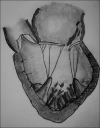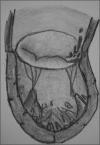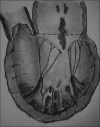Ischemic mitral regurgitation
- PMID: 28994679
- PMCID: PMC5661313
- DOI: 10.4103/aca.ACA_58_17
Ischemic mitral regurgitation
Abstract
Ischemic mitral regurgitation (IMR) is a frequent complication of left ventricular (LV) global or regional pathological remodeling due to chronic coronary artery disease. It is not a valve disease but represents the valvular consequences of increased tethering forces and reduced closing forces. IMR is defined as mitral regurgitation caused by chronic changes of LV structure and function due to ischemic heart disease and it worsens the prognosis. In this review, we discuss on etiology, pathophysiology, and mechanisms of IMR, its classification, evaluation, and therapeutic corrective methods of IMR.
Conflict of interest statement
There are no conflicts of interest.
Figures







Comment in
-
Rationale for change in the criteria for defining severe ischemic mitral regurgitation in 2017 American College of Cardiology/American heart association guidelines.Ann Card Anaesth. 2018 Oct-Dec;21(4):464-465. doi: 10.4103/aca.ACA_51_18. Ann Card Anaesth. 2018. PMID: 30333353 Free PMC article. No abstract available.
References
-
- Piérard LA, Carabello BA. Ischaemic mitral regurgitation: Pathophysiology, outcomes and the conundrum of treatment. Eur Heart J. 2010;31:2996–3005. - PubMed
-
- Bursi F, Enriquez-Sarano M, Nkomo VT, Jacobsen SJ, Weston SA, Meverden RA, et al. Heart failure and death after myocardial infarction in the community: The emerging role of mitral regurgitation. Circulation. 2005;111:295–301. - PubMed
-
- Lamas GA, Mitchell GF, Flaker GC, Smith SC, Jr, Gersh BJ, Basta L, et al. Clinical significance of mitral regurgitation after acute myocardial infarction. Survival and ventricular enlargement investigators. Circulation. 1997;96:827–33. - PubMed
-
- Serri K, Bouchard D, Demers P, Coutu M, Pellerin M, Carrier M, et al. Is a good perioperative echocardiographic result predictive of durability in ischemic mitral valve repair? J Thorac Cardiovasc Surg. 2006;131:565–73.e2. - PubMed
Publication types
MeSH terms
LinkOut - more resources
Full Text Sources
Other Literature Sources
